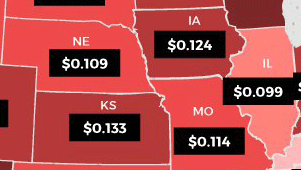Creature comforts are a necessity for most Americans, whether you rent or own a home. While we all might have different ideas of comfort, most of us would list electricity as a top priority. Whether you’re just coming out of a sweltering Texas summer with the AC blasting or you’re entering a deep New England winter with the heater at your bedside, electricity makes lives livable in more ways than one. With the holiday season rapidly approaching, electricity rates become more important than ever with shorter days and longer nights. So when Elite Fixtures released this map of comparing electricity rates by state, we took notice.
Videos by Rare
While they also feature commercial electricity rates in every state, we care about residential electricity rates, especially as we’re entering the season of air conditioning.

Let’s recap these average electricity prices per state, based on kilowatt per hour.
Alabama: $.09 KWH
Alaska: $.28 KWH
Arizona: $.12 KWH
Arkansas: $.10 KWH
California: $.13 KWH
Colorado: $.13 KWH
Connecticut: $.15 KWH
Delaware: $.10 KWH
District of Columbia: $.08 KWH
Florida: $.12 KWH
Georgia: $.11 KWH
Hawaii: $.30 KWH
Idaho: $.10 KWH
Illinois: $.09 KWH
Indiana: $.12 KWH
Iowa: $.12 KWH
Kansas: $.13 KWH
Kentucky: $.08 KWH
Louisiana: $.09 KWH
Maine: $.11 KWH
Maryland: $.09 KWH
Massachusetts: $.14 KWH
Michigan: $.10 KWH
Minnesota: $.11 KWH
Mississippi: $.09 KWH
Missouri: $.11 KWH
Montana: $.09 KWH
Nebraska: $.10 KWH
Nevada: $.06 KWH
New Hampshire: $.13 KWH
New Jersey: $.10 KWH
New Mexico: $.14 KWH
New York: $.12 KWH
North Carolina: $.11 KWH
North Dakota: $.09 KWH
Ohio: $.10 KWH
Oklahoma: $.10 KWH
Oregon: $.07 KWH
Pennsylvania: $.09 KWH
Rhode Island: $.13 KWH
South Carolina: $.12 KWH
South Dakota: $.11 KWH
Tennessee: $.06 KWH
Texas: $.11 KWH
Utah: $.10 KWH
Vermont: $.17 KWH
Virginia: $.07 KWH
Washington: $.07 KWH
West Virginia: $.10 KWH
Wisconsin: $.13 KWH
Wyoming: $.11 KWH
Based on these numbers from Elite Fixtures, Hawaii and Alaska lead the charge for the most expensive residential electricity rates.
For the continental U.S., the most expensive states are, in descending order: Vermont, Connecticut, Massachusetts, New Mexico, Wisconsin, Rhode Island, California, and New Hampshire. New England has it quite rough, especially considering their colder winters.

As far the lowest residential electricity rates, the least expensive states, in descending order, are: Maryland, Louisiana, Missouri, Kentucky, Washington, D.C., Virginia, Washington, Oregon, Tennessee, and Nevada.
It seems that states in the Heartland are prone to more average electricity rates instead of the lower end of the spectrum.

Texas itself is one of the less expensive states to live in when it comes to electricity rates, but that’s still no reason to waste if you don’t have to. However, because it is the summertime and electric bills are necessary, it’s important to know where your own budget stands in relation to the bill that arrives every single month.
Will these rates change as more sustainable forms of energy become popular? Only time will tell, but if you’re about to fire up the oven, why not try out some of our sister site Wide Open Eats‘ best recipes? Our Enchilada Chili Bake is a crowd-pleasing weeknight dinner that comes together quickly. Feeling something sweet? Our Flourless Chocolate Cake is a fun baking experiment, especially to try with the kiddos.
Want to embrace your inner Texan? King Ranch recipes are pure comfort food in a bite. Just be mindful of how you’re using your electricity this season! Much like budget-planning for your meals, it pays to budget your electric use.



